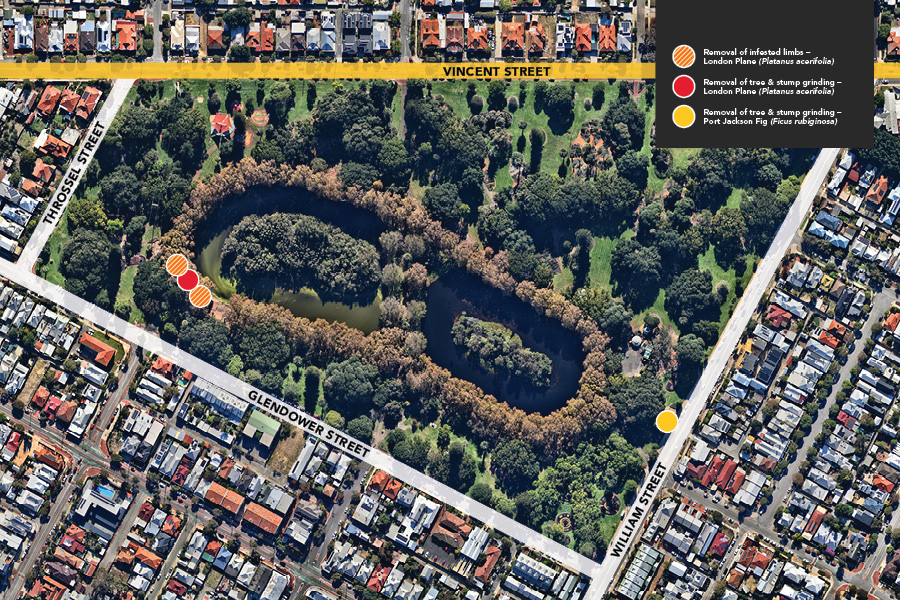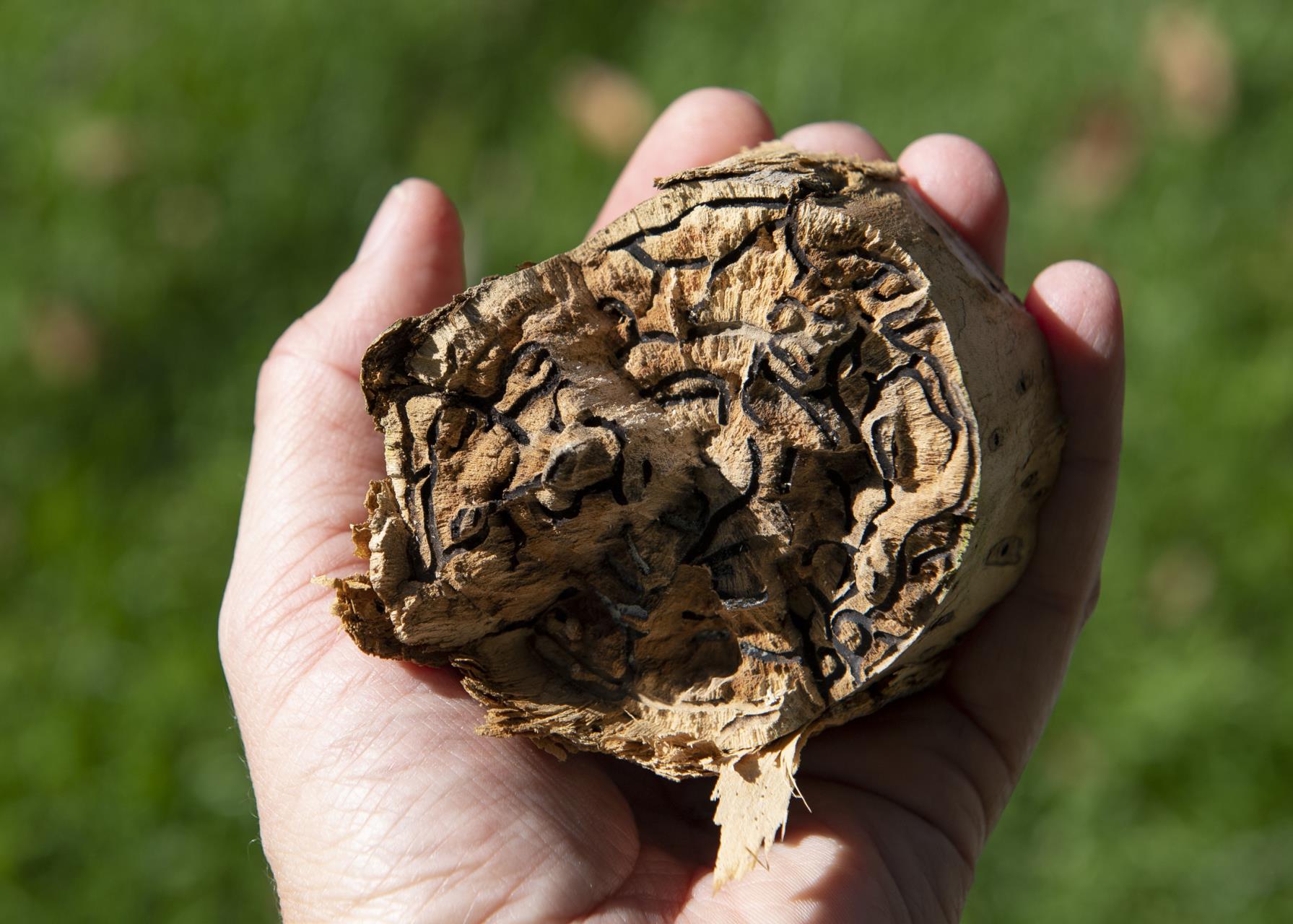Polyphagous shot-hole borer
The City of Vincent is working with the Department of Primary Industries and Regional Development’s (DPIRD) to help stop the spread of invasive pest, the Polyphagous shot-hole borer (PSHB). PSHB is a serious issue across the Perth metropolitan area. It attacks by tunnelling into trunks and branches and can spread quickly to other trees once established.
The best source of information on PSHB is always the DPIRD website.
Check your trees
If you suspect borer damage, report it to DPIRD on 9368 3080, [email protected], or via the MyPestGuide app.
PSHB in Vincent
In addition to private properties in Vincent, PSHB has been discovered in our parks and reserves. The following locations have been identified by DPIRD for ongoing treatment:
- Hyde Park
- Banks Reserve
- Forrest Park
- Robertson Park
- Mick Michael Park
- Beatty Park
- Loton Park/HBF Park
- Stuart Street Reserve
Hyde Park
DPIRD has confirmed a significant polyphagous shot-hole borer (PSHB) infestation at Hyde Park.
The health of our tree canopy is our priority. We are doing everything we can minimise tree loss. We continue to work closely with DPIRD and further inspections has been undertaken with arborists over the past few months.
Treatment at Hyde Park will start with the most heavily infested trees. The first stage will involve the removal of two trees and the pruning of two more. These works will start on 14 October 2024 and take about a week.
The treatment is necessary to control the spread of this invasive pest, ensure public safety and protect surrounding healthy trees.
It is anticipated that further treatment will be required and we will keep the community updated as information becomes available.
We continue to work with the community on plans for a replanting program that will see Hyde Park protected for future generations.
PSHB treatment at Hyde Park
October 2024

About PSHB
What is PSHB?
Polyphagous shot-hole borer or PSHB (Euwallacea fornicatus) is a beetle native to Southeast Asia. About the size of a sesame seed, PSHB excavates tunnels in trees where they cultivate fungus as a food source.
This fungus spreads in the tunnels of trees disrupting the flow of water and nutrients.
Trees damaged by PSHB can become a constant source of beetles that can disperse and impact neighbouring trees.
Check out the explainer video below:
How is it being managed?
The City of Vincent is following the lead of DPIRD as part of a nationally funded and coordinated emergency response to eradicate the borer from Western Australia.
DPIRD's response activities include:
- Conducting surveillance to determine the distribution of PSHB.
- Containing the pest to prevent further spread to non-infested regions within Western Australia.
- Providing advice and information to residents, industry and other stakeholders.
- Ensuring that all response activities are conducted safely, consistently and efficiently.
- Removing infested trees to save healthy trees.
Quarantine area
Vincent is included in DPIRD’s Quarantine Area.
It is important that people living or working within the Quarantine Area are aware of the restrictions on the movement of wood and plant material from their properties as they could act as hosts and potentially spread the borer.
PSHB does not affect grass so lawn clippings can be disposed of as normal.
Vincent is working with DPIRD to stop the spread of PSHB.
Quarantine area sheet
What happens to trees after they are removed?
DPIRD have a Tree Management Plan in place to guide the removal of trees and tree limbs in a way that will ensure the beetle is destroyed. Under this plan, all material from infested trees is chipped on site to a size less than 2.5cm. At this size, PSHB is not able to survive in the wood. The woodchips are then securely transported to a facility in Jandakot.
What are the signs a tree is infested?
The top hosts of PSHB include Maple (Acer), Plane (Platanus), Robinia (Robinia), Poplars (Populus), Oak (Quercus), Avocado (Persea), Fig (Ficus) and Coral Tree (Erythrina).
Symptoms of infestation vary from species to species. The main things to look for include:
- Beetle entry/exit holes - approximately the size of a ballpoint pen tip.
- Galleries - when pruning branches or inspecting fallen branches, check for evidence of galleries caused by the tunnelling action of PSHB beetles.
- Discoloration/staining - this is caused by the Fusarium fungus.
- Gumming - thick resin or sap.
- Frass - produced by the beetles tunnelling, frass or 'noodles' may be seen on the tree exterior. This can indicate a high level of infestation.
- Sugar volcanoes - a common sign of infestation on Avocado trees, crystalline foam is exuded from entry/exit holes.
- Dieback and tree death - the fungus disrupts the tree vascular symptom causing dieback and death.
The female beetles are approximately 2mm in length, range from brown to black in colour and can fly to other close by trees.
The male beetles are smaller, at around 1.6mm in length, they don’t have wings and prefer to stay inside the tree.
Symptoms are not always obvious, if a tree is looking generally unwell, or there are early signs of dieback, inspect the tree closely for evidence of small bore holes.
If you see one, you are likely to see more, as they are often clustered in a shotgun pattern.

Removal of trees from the lakes at Hyde Park
DPIRD has confirmed that trees will need to be removed from the two islands in the middle of the lakes at Hyde Park. As part of this work, approvals and controls will be in place to protect wildlife. The City already has plans to revegetate the islands and restore habitat as quickly as possible after DPRID's works.
More information
Find out more about PSHB on:
Department of Primary Industries and Regional Development
Latest news
Posted 10 December 2024
Polyphagous shot-hole borer treatment at Beatty Park
The Department of Primary Industries and Regional Development has confirmed an infestation of Polyphagous shot-hole borer at Beatty Park.
Posted 08 October 2024
Polyphagous shot-hole borer treatment at Hyde Park
Treatment will start with the most heavily infested trees from 14 October 2024.
Posted 21 February 2024
Hyde Park Reference Group nominations open
We are looking for volunteers to guide the restoration of our tree canopy.
Posted 19 April 2023
PSHB Treatment at Hyde Park
The Department of Primary Industries and Regional Development will be undertaking works in Hyde Park from late May to stop the spread of the invasive pest Polyphagous shot-hole borer.
Posted 24 January 2023
PSHB Tree Management at Hyde Park
The Department of Primary Industries and Regional Development will be treating trees infected by the Polyphagous shot-hole borer at Hyde Park in Feburary.
1